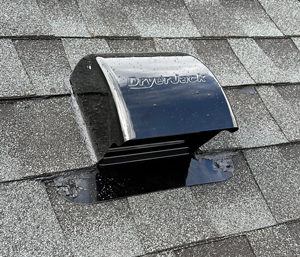Specifications
The DryerJack® is built tough in the USA. Advanced model 477 is deep draw manufactured with heavy gauge Galvalume® steel and designed for low-profile, airflow-efficient performance. The hood’s wide opening, protected by a patented, curved damper, is cleaning tool accessible and handles the demanding needs for properly venting a dryer.- Made of Rugged Heavy Gauge Galvalume® Steel
- Complies With Building Code: IMC 504 & IRC 1502
- Includes Nail Holes for Installation Ease
- Protects with Seamless Hood and Unibody Base
- Available in Three, Heavy Powder-Coated Colors
 DryerJack Model DJK477 installed
DryerJack Model DJK477 installed
Section 11 30 14 - Residential Dryer Venting Specs by Zero Docs: Master Format 04
Special Requirements
DryerJacks are optimally designed for roof pitch between 3/12 and 12/12. Select Model 486U with an integrated curb cover to deliver maximum weather protection for flat roof installations (less than 3/12 pitched roof). Roof pitch in excess of 45 degrees will render the damper ineffective.
Installation
- Tools Needed
- Tape Measure
- Flat Pry Bar
- Caulk Gun
- Reciprocating Saw
- Battery Powered Drill
- Hammer
- Material Needed
- Leather Gloves
- DryerJack Model - 477
- Silver Foil Tape
- Roofing Cement (1-2 tubes)
- Galvanized Screws or Nails
GENERAL: Before installation, ensure that the substrate (roofing material) is uniform and even. Installation shall be made in accordance with recognized sheet metal practices. SMACNA Architectural Sheet Metal Manual 6th Ed. Specifications shall be used as a guide and basis for detail whenever applicable.
NOTE: Recommended use of this product is for exhaust of warm dry or slightly moist air only. This product is not intended for venting exhaust grease or liquid.
DryerJack Installation Tips Video
RoofNeck Installation Tips Video
DryerJack Installation
The DryerJack 477 is designed specifically for venting the dryer through the roof. For optimal results, install the DryerJack with the versatile RoofNeck collar.
Professional installation is recommended.
Step 1: Start by determining the location to install the roof vent.
Step 2: Using the included template, drill a pilot hole on the “X” to mark the center of the hole location for ductwork.
Step 3: Trace around the perimeter of the template.
Step 4: From the pilot hole mark, cut a four and one quarter inch circular hole into roof deck for the ductwork.
Step 5: If installing the RoofNeck collar, begin at Step 3 in those instructions and complete the RoofNeck installation.
Step 6: Cut the roof covering along the traced line and remove.
Step 7: Apply roofing sealant along the underside of the flange.
Step 8: Slide the flange underneath the shingles.
Step 9: Using the predrilled holes, secure to the roof deck with corrosion resistant nails or screws.
Step 10: Apply roofing sealant to the underside of the shingles and lay over the flange.
Step 11: Finish the installation by applying roofing sealant around the base of the hood and exposed fasteners.
The DryerJack is now ready for use.
- Dry-fit the duct work assembly that will run from the dryer to the roof. Draw a circle around the perimeter of the duct work onto the underside of the roof sheathing.
- Drive a nail upward through the roof, from the inside to mark the center location of the vent.
- Access the roof and locate the nail (where the shingles are lifted up slightly is an indication). Cut a hole slightly larger than the duct pipe of the hood with a reciprocating saw.
- Place the vent hood into position and trace the outline of the flashing so you know the areas where you need to lift the shingles to get the flashing underneath.
- Lift the shingles on the sides and top of the hole where the flashing will go with a flat bar. Remove the nails that hold those shingles in place by carefully sliding the flat bar between the shingles and the roof sheathing.
- Dry-fit the vent to confirm adequate shingle lifting and removal is sufficient. Remove vent and apply liberally roofing cement to the areas of the roof and vent where they come in contact with each other. Install vent, mechanically fasten the flashing plate to the roof deck using nails or stainless steel screws in predrilled holes where possible, making sure the top edge of the flashing is underneath the loosened shingles on the top and sides of the vent so the shingles overlap the edge of the flashing. This helps prevent water from seeping underneath the flashing.
- Allow the front part of the flange to lie over the shingles (so water runs down). Apply roofing cement or roofing silicone caulk around the edges of the flashing (DO NOT fill or block the drainage slot on the low side of the vent) as well as a “smear” on each nail head.
- Apply roofing cement to the underside of the detached shingles. Apply the roofing cement only to the shingles covering the back and sides of the roof vent's flange.



